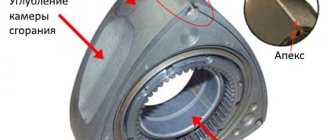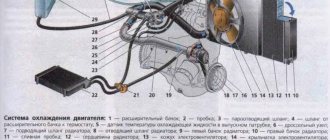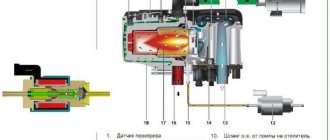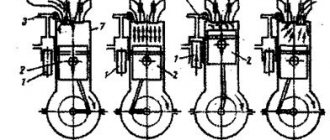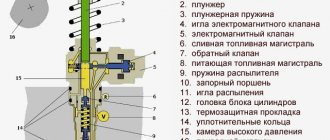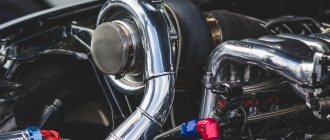The internal combustion engine is a brilliant invention of mankind. Thanks to the internal combustion engine, technological progress began to develop significantly. There are several types of these settings. But the most famous are connecting rod-piston and rotary-piston. The latter was invented by the German engineer Wankel in collaboration with Walter Freude. This power unit has a different design and operating principle when compared with the classic connecting rod-piston internal combustion engine. What is the operating principle of the Wankel engine and why has this internal combustion engine not become so popular? We will look at all this in our article today.
Characteristic
So what kind of motor is this? This is an internal combustion engine that was developed by Felix Wankel in 1957. The function of the piston in this unit was performed by a three-vertex rotor. He performed rotational movements inside a cavity of a special shape.
After a number of experimental models of motorcycles and cars that occurred in the 70s of the last century, the demand for the Wankel engine decreased significantly. Although today a number of companies are still working to improve this internal combustion engine. So, you can find a Wankel engine on a Mazda PX series. This unit has also found its application in modeling.
Aircraft engines
In the early 1950s, a series of aircraft engines VP-760, VP-1300, VP-2650 were created - five-beam two-stroke stars with power from 40 to 130 hp. With. and weighing from 25 to 100 kg, an employee of the Perm Engine Plant 19, aviation engineer Valentin Valentinovich Polyakov (piston engines; rotating spool timing and two-stage pistons combined with injection pistons have nothing to do with Wankel) created for light aircraft and successfully tested in small series in DOSAAF.[4] Later, in the 1990s, the VAZ-416, VAZ-426, and VAZ-526 were created at the VAZ Scientific and Technical Center.
Despite a number of attempts to install the Wankel engine on aircraft (prototypes have been tested in different countries since the 1950s), it has not found widespread use in aviation. Currently (2011) the Wankel engine is installed on some models of Schleicher motor gliders.
Wankel engine design
This power unit consists of several components:
- Housing (stator).
- Combustion chambers.
- Inlet and outlet windows.
- Fixed gear.
- Gear wheel.
- Rotor.
- Vala.
- Spark plug.
What is the operating principle of the Wankel engine? We will look at this below.
The end of euphoria
In 1964, the NSU Spyder was released, and after it the legendary Ro 80 model was released. And now there are quite a lot of clubs around the world for fans of these cars. Then such models as the Corvette XP, Mercedes C-111, and Citroen M35 rolled off the assembly line. However, the only company that engaged in mass production was Mazda. Since 1967, it has produced 2-3 new cars with RPD. The Wankel engine was installed on light aircraft, snowmobiles, and boats. In 1973, the end of the euphoria came. At that time, the oil crisis was in full swing. It was during this period that the main drawback of RPD manifested itself - unprofitability. Except for Mazda, all manufacturers have curtailed their programs for the production of cars with rotary engines. However, only Mazda continued to produce such cars. The company's sales in America have declined significantly.
Principle of operation
This internal combustion engine operates as follows. The rotor, mounted on an eccentric shaft through bearings, is driven by the force of gas pressure that is formed as a result of the combustion of the fuel-air mixture. The motor rotor is relative to the stator through a pair of gears. One of them (large) is located on the inner surface of the rotor. The second (support) has smaller dimensions and is tightly attached to the side cover of the engine. Thanks to the interaction of the gears, the rotor produces eccentric circular movements. Thus, its edges are in contact with the inner surface of the combustion chamber.
As a result, several isolated chambers of variable volume are formed between the engine housing and the rotor. Their number is always 3. In these chambers, the process of compression of the mixture, its combustion, expansion of gases (which subsequently exert pressure on the working surface of the rotor) and their removal take place. As a result of fuel ignition, the rotor is driven, transmitting torque forces to the eccentric shaft. The latter is mounted on bearings and then transmits power to the transmission units. And only then the torque of the Wankel engine goes to the wheels according to the classical scheme - through a cardan transmission and axle shafts to the hubs. Thus, several mechanical pairs operate simultaneously in a rotary motor. The first is responsible for the movement of the rotor and consists of several gears. The second converts the movement of the rotor into revolutions of the eccentric shaft.
The gear ratio of the stator (housing) and gears is always stable and is 3:2. Thus, the rotor manages to rotate 120 degrees per full rotation of the shaft. In turn, for a full revolution of the rotor, a four-stroke cycle of operation of the internal combustion engine is performed in each of the three chambers formed by the faces.
RPD VAZ
RPD VAZ 311
• Model VAZ-311 • Type rotary-piston, four-stroke, benzine-free, carburetor • Number of sections 1 • Stator width, mm 80 Parameters of the epitrochoidal surface of the stator:
• generating radius, mm 102 • eccentricity, mm 15 • Reduced working volume, l 0.654 • Compression ratio 9.4 • Rated power according to GOST at an eccentric shaft speed of 6000 rpm, hp.
(not less than) 70 • Maximum torque at eccentric shaft rotation speed 3500-4000 rpm, kgf m (not less) 9.7 • Minimum eccentric shaft rotation speed at idle speed, rpm 900-950 • Oxide content carbon (CO) in exhaust gases at idle speed, % (no more) 2 VAZ-21018 car with VAZ 311 rotary piston engine Maximum speed, km/h
• with the highest load 143 • with driver and passenger 145
Acceleration time from standstill with gear shifting up to a speed of 100 km/h, s
• with the highest load 20 • with driver and passenger 18
Fuel consumption per 100 km in the summer for a run-in car when driving in top gear with a full load (no more), l
• at speed 80 km/h 8.2
in winter, control fuel consumption should not exceed the specified values by more than 10%
• Oil consumption from fuel consumption, % 1
RPD VAZ-415
• Model VAZ-415 • Type rotary piston, four-stroke, benzine, carburetor • Number of sections x working volume of the chamber, l 2x0.654 • Stator width, mm Parameters of the epitrochoidal surface of the stator:
• generating radius, mm • eccentricity, mm • Reduced working volume, l 2x0.654 • Compression ratio 9.4 • Rated power according to GOST 14846 -81 (net) at an eccentric shaft speed of 6000 rpm, kW (hp) 99.2 (135) • Maximum torque according to GOST 14846-81 (net) at an eccentric shaft rotation speed of 4000 rpm, Nm (kgf m) 176(18) • Minimum eccentric shaft rotation speed at idle mode, rpm 900 • Volume fraction of carbon monoxide (CO) at idle mode, no more, % 1.5
Car VAZ-2108/2109/21099/2115-91
• Maximum speed, km/h 190
Acceleration time from standstill with gear shifting to a speed of 100 km/h, s
• with gross weight 9.5 • with one passenger 8.5
Consumption fuel per 100 km of travel, no more than, l
• at a speed of 90 km/h 7.8 • at a speed of 120 km/h 10.5 • in the urban driving cycle 14.5 • Oil consumption from fuel consumption, % 0.6 AVIATION VAZ-426 ROTARY PISTON ENGINE IS DESIGNED FOR LIGHT AIRCRAFT COMPACT, LOW VIBRATION, EASY MAINTENANCE, INCREASED POWER WITH MINIMAL CHANGES
Technical characteristics:
• Engine type rotary piston, four-stroke , with spark ignition and liquid cooling • Number of sections 3 • Working volume of the chamber, dm3 0.654 • Compression ratio 9.4
Power, kW (hp)/min-1 (gearbox output shaft speed)
• /takeoff 154.4(210)/279.6 • Specific fuel consumption g/ kW h (g/hp h) in cruising mode 292 (205) • Direction of rotation of the propeller shaft (from the power take-off side) right
Gearbox
• Single-stage gear ratio with helical gears 0.466 • Liquid cooling system, closed (Tosol-A40M, Tosol-A65M) • Combined lubrication system, with a “wet” sump • Oil consumption at cruising mode, kg/h 0.3 • Oil grades: mineral oils with an API quality level no worse than SF • Fuel supply system: phased injection with electronic control and redundancy mechanical system
Fuel grades
• primary motor gasoline with an OC of at least 90 • reserve aviation gasoline B-91/115 • Electronic magneto ignition system • Electric starting system, starter (rated supply voltage 24 V) • Engine dry weight, kg (with gearbox) 145
Overall dimensions, mm:
• height 600 • width 600 • length 1050
Operating conditions:
• ambient temperature -50...+50 C • altitude above sea level, m 3000
Advantages
What are the advantages of this internal combustion engine? The Wankel rotary piston engine has a simpler design than the connecting rod piston engine. Thus, the number of parts in it is 40 percent less than in a piston four-stroke internal combustion engine. But it is still not possible to create a Wankel engine with your own hands without sophisticated equipment. After all, the rotor has a very complex shape. Those who tried to make a homemade Wankel engine with their own hands suffered numerous failures.
But let's continue about the benefits. The design of the rotary unit does not include a crankshaft or a gas distribution mechanism. There are also no connecting rods or pistons. The combustible mixture enters the chamber through the inlet window, which opens at the edge of the rotor. And the exhaust gases at the end of the power stroke are released into the housing through the exhaust window. Again, the role of the valve here is played by the face of the rotor itself. Also, the design lacks a camshaft (of which several are now used on connecting rod units). The Wankel rotary piston engine is similar in principle to the gas distribution mechanism to a two-stroke engine.
Separately, it is worth mentioning the lubrication system. In fact, it is absent in the Wankel rotary engine. But how then do friction pairs work? It's simple: oil is added to the combustible mixture itself (as in primitive motorcycle engines). Thus, the lubrication of rubbing parts is carried out by the air-fuel mixture itself. The design lacks the usual oil pump, which takes lubricant from the sump and sprays it under special pressure.
Another advantage of the Wankel engine is its light weight and size. Since almost half of the parts that are mandatory in piston engines are missing here, the rotary unit is more compact and can fit in any engine compartment. compact dimensions allow you to use the engine compartment space more efficiently, as well as provide a more uniform load on the front and rear axles (after all, in a car with conventional engines, more than 70 percent of the load falls on the front part). And due to the low weight, high stability of operation is achieved. Thus, the engine has a minimal level of vibration, which has a positive effect on the comfort of the machine.
The next advantage of this unit is its high power density, which is achieved at high shaft speeds. This feature allows you to achieve good technical characteristics. This is why the Wankel engine is used in Mazda sports cars. The engine easily spins up to seven thousand revolutions or more. At the same time, it provides much greater torque and power in a small volume. All this has a positive effect on the acceleration dynamics of the car. For example, you can take the Mazda RX-8 car. With a volume of 1.3 liters, the engine produces 210 horsepower.
ADVANTAGES AND DISADVANTAGES OF RPD
Advantages:
➤ smaller dimensions and weight;
➤ fewer parts (even in comparison with a two-stroke piston internal combustion engine); ➤ twice the power with the same dimensions as traditional internal combustion engines; ➤ smooth operation due to the absence of reciprocating moving parts; ➤ possibility of consuming low-octane gasoline. Disadvantages:
➤ inefficient combustion process, which means increased fuel consumption and toxicity of exhaust gases; ➤ burnout lubrication, which entails high oil consumption; ➤ impossibility of production in areas intended for the production of traditional internal combustion engines; ➤ transition to RPD production requires replacement of the vast majority of equipment. The rotary piston engine captivates with its simplicity: the housing, the shaft, the rotor itself - and that’s it. True, there are problems with the rotor seals. It took decades to solve them, and in the end the service life of the seals was brought to match the service life of the piston rings in the internal combustion engine.
The disadvantages include the unfamiliarity of the Wankel engine for both repairmen and owners. This motor requires changing many habits. So, it is useless to slow down the RPD, and even more so to storm the climbs “pull-up”. The compact rotor has low inertia, unlike the massive parts of a traditional internal combustion engine. Frequent start-ups and shutdowns “throw” the spark plugs. The sound of the engine is also unusual, although many consider this an advantage. Much more serious are the organic shortcomings inherent in RPD. Firstly, this is low elasticity characteristics and increased fuel consumption. The latter is explained by high heat losses through the walls of the chamber, which is far from optimal. Secondly, oil consumption is especially high. The service life of such a motor is also lower than that of a traditional one due to rapid wear of the rotor seals. An important role is also played by the rigidity of the external characteristics of the RPD, which requires more frequent manipulations of the gearshift lever - in practice, this is expressed in a “shorter” gear range, and therefore an increased number of gears. It would be ideal to install a variator, but automatic transmissions have not caught on in sports cars, and it’s strange to see an RPD on a family car, if only because of insufficient efficiency. The disadvantages of rotary piston engines are the same as those of two-stroke piston engines. The funny thing is that many of these diseases are “treated” in the same way. Increased “appetite” - direct fuel injection, insufficient elasticity - variable phases and pipeline configuration. What was done on the engine for the Mazda RX-8 coupe.
Design flaws
Considering the design and principle of operation of the Wankel rotary engine, it is worth noting the main design flaw. This is the low efficiency of sealing the gap between the combustion chamber and the rotor. The latter has a rather complex shape, which is why it requires reliable sealing not only along the edges (of which there are four in total), but also along the side surface (which are in contact with the engine cover). Moreover, they are made in the form of spring-loaded steel strips with particularly precise processing both from the ends and from the working surfaces. All allowances for expansion during heating included in the design worsen these characteristics. Because of this, it is impossible to avoid gas breakthrough at the end points of the sealing plates. In piston engines, the labyrinth effect is used. Thus, the design uses three sealing rings with gaps in different directions.
But it is worth noting that in recent years the quality of seals has increased. The designers improved the Wankel engine by using new materials for seals. But still, gas breakthrough is considered the weakest point in a rotary internal combustion engine.
Device problems and their resolution
Felix Wankel managed to overcome most of the problems that caused previous rotary devices to fail:
- Rotary RPMs have a problem not found in four-stroke piston units, in which the block housing has intake, compression, combustion and exhaust gases flowing at fixed locations around the housing. The use of heat pipes in air-cooled Wankel rotary engines was proposed by the University of Florida to overcome uneven heating of the housing block. Preheating some body sections with exhaust gases improved performance and fuel economy, while also reducing wear and emissions.
- Problems also arose during research in the 50s and 60s. For some time, engineers had been confronted with what they called a “devil's scratch” on the inner surface of the epitrochoid. They discovered that the cause was pinpoint compactions reaching resonant vibration. This problem was solved by reducing the thickness and weight of the mechanical seals. The scratches disappeared after the introduction of more compatible sealing and coating materials.
- Another early problem was the growth of cracks on the stator surface near the plug hole, which was eliminated by installing the spark plugs in a separate metal insert, a copper bushing in the housing instead of a plug screwed directly into the block housing.
- Four-stroke piston devices are not very suitable for use with hydrogen fuel. Another problem is related to hydration on the lubricant film in piston designs. In Wankel internal combustion engines, this problem can be circumvented by using a ceramic mechanical seal on the same surface, so that there is no oil film to suffer from hydration. The piston shell must be lubricated and cooled with oil. This significantly increases the consumption of lubricating oil in a four-stroke hydrogen internal combustion engine.
Oil consumption
As we said earlier, there is no lubrication system as such in this engine. Due to the fact that the oil comes along with the combustible mixture, its consumption increases significantly. And if on connecting rod engines the natural loss of lubricant is excluded or is no more than 100 grams per 1 thousand kilometers, then on rotary engines this parameter ranges from 0.4 to 1 liter per thousand kilometers. This is because the complex sealing system requires more efficient lubrication of the surfaces. Also, due to high oil consumption, these engines cannot meet modern environmental standards. The exhaust gases of cars with Wankel engines contain many substances hazardous to the body and the environment.
In addition, the rotary engine could only operate on high-quality and expensive oils. This is due to several factors:
- The tendency of the contacting parts of the engine chamber and rotor to suffer high wear.
- Tendency of friction pairs to overheat.
Advantages over other designs
Unlike more common piston designs, the Wankel engine offers the advantages of simplicity, smoothness, compactness, high rpm and a high power-to-weight ratio.
This is primarily due to the fact that three power pulses are produced per revolution of the Wankel rotor, compared to one revolution in a two-stroke piston engine and one per two revolutions in a four-stroke engine. A RPM is commonly referred to as a rotary motor. Although this name also applies to other designs, most notably aircraft engines with their cylinders located around the crankshaft.
The four-stage cycle of intake, compression, ignition and exhaust occurs at each revolution on each of the three rotor tips, which move inside an oval-matched cross-drilled housing, allowing for three times as many pulses per rotor revolution. The rotor is similar in shape to the Reule triangle, and its sides are flatter.
Additionally, we recommend reading our specialist’s article, which talks about how an external combustion engine works.
Other problems
Irregular oil changes threatened to reduce the life of the internal combustion engine, since particles of the old lubricant acted as an abrasive, increasing the gaps and the likelihood of exhaust gases breaking through in the chamber. This unit also jams when overheated. And when driving in cold weather, the cooling could be excessive.
The RPD itself has a higher operating temperature than any piston engine. The combustion chamber is considered the most loaded. it has a small volume. And due to its extended shape, the chamber is prone to detonation. In addition to oil, the Wankel engine is demanding on the quality of spark plugs. They are installed in pairs and changed strictly according to technical regulations. Among other points, it is worth noting the insufficient elasticity of the rotary motor. Thus, these internal combustion engines can produce excellent speed and power characteristics only at high rotor speeds - from 6 to 10 thousand or more per minute. This feature forces designers to modify the design of gearboxes, making them multi-stage.
Another drawback is high fuel consumption. For example, if we take the 1.3-liter rotary piston engine of the Mazda RX-8, according to the passport data, it consumes from 14 to 18 liters of fuel. Moreover, only high-octane gasoline is recommended for use.
Wankel history
The life of Felix Heinrich Wankel was not easy; he was left an orphan at an early age (the father of the future inventor died in the First World War), Felix could not raise funds to study at the university, and his working specialty did not allow him to obtain severe myopia.
This prompted Wankel to independently study technical disciplines, thanks to which in 1924 he came up with the idea of creating a rotary engine with a rotating internal combustion chamber.
In 1929, he received a patent for the invention, which became the first step towards the creation of the famous Wankel RPD. In 1933, the inventor, finding himself in the ranks of Hitler's opponents, spent six months in prison. After liberation, the BMW company became interested in the development of a rotary engine and began to finance further research, allocating a workshop in Landau for the work.
After the war, it goes to the French as reparation, and the inventor himself goes to prison as an accomplice of the Hitler regime. Only in 1951, Felix Heinrich Wankel got a job at the NSU motorcycle manufacturing company and continued his research.
In the same year, he began working together with the chief designer of NSU, Walter Freude, who himself had long been engaged in research in the field of creating a rotary piston engine for racing motorcycles. In 1958, the first sample of the engine took place on the test bench.
On the use of RPD in the automotive industry
This engine gained the greatest popularity in the late 60s and early 70s of the last century. The patent for the Wankel RPD was acquired by 11 leading automakers. So, in 1967, the NSU company developed the first business class car with a rotary engine, which was called NSU RO 80. This model was mass-produced for 10 years. In total, more than 37 thousand copies were produced. The car was popular, but the shortcomings of the rotary engine eventually tarnished the car's reputation. Compared to other NSU models, the NSU RO 80 sedan was the most unreliable. The mileage before the overhaul was only 50 thousand, compared to the stated 100.
The Peugeot-Citroen concerns and the VAZ plant also experimented with rotary engines (we will talk about this case separately below). The Japanese achieved the greatest success by releasing a passenger car with a rotary engine in 1963. At the moment, the Japanese are still equipping RPD on their RX series sports cars. To date, they have been freed from many of the “childhood diseases” that were inherent in the RPD of that time.
Rotary vane engine
The idea of such a heat engine was proposed back in 1910 in Germany. But only on paper. Things didn’t go further than ideas, drawings and diagrams. The design of the engine seemed too controversial and fantastic at that time, although theoretically there was nothing complicated about it. The engine was a cylinder in which two independent shafts were coaxially placed. A block of two blades was rigidly fixed on each of them. The blades divide the cylinder into four independent chambers, and each chamber performs four power strokes per revolution. This is what attracted the designers - in theory, such a motor could replace a piston engine with 8 cylinders. The advantages are obvious:
- compact dimensions;
- high efficiency;
- no complex gas distribution mechanism is needed.
This design could not be implemented at the beginning of the century, so it was taken up in the 90s. Technologies have advanced, new materials have appeared, but... Not a single working copy of a rotary-blade engine has been manufactured, and it exists only as a utopian project. Despite the fact that in 2002 information appeared about possible solutions to technical problems with the implementation of this project, work has not yet been carried out and the design is considered unpromising.
RPD Wankel and the motorcycle industry
In the 70s and 80s of the last century, some motorcycles and Suzukis experimented with rotary engines. Now mass production of rotary motorcycles has been established only in. This brand produces NRV588 sportbikes, equipped with twin-rotor engines with a total volume of 588 cubic centimeters. The power of the Norton bike is 170 horsepower. with a curb weight of 130 kilograms, this motorcycle has excellent dynamic characteristics. Additionally, these RPDs are equipped with an electronic fuel injection system and a variable intake tract.
Today's day
Today, the Mazda RX-8 is in serial production, equipped with a Renesis engine (abbreviation Rotary Engine + Genesis).
The designers managed to reduce oil consumption by half and fuel consumption by 40%, and brought the environmental class to the Euro-4 level. The engine with a displacement of 1.3 liters produces a power of 250 hp. With.
Despite all the achievements, the Japanese do not stop there. Contrary to the claims of most experts that RPD has no future, they do not stop improving the technology, and not so long ago they presented the concept of the RX-Vision sports coupe, with a SkyActive-R rotary engine.
What else is worth reading
Operating principle of the engine cooling system
Types of carburetors
Engine overheating
About the diesel engine
Interesting Facts
These power units are widely used among aircraft modellers. Since the model internal combustion engine does not have requirements for efficiency and reliability, the production of such engines turned out to be inexpensive. In such internal combustion engines there are no rotor seals at all, or they have the most primitive design. The main advantage of such an aircraft model unit is that it is easy to install in a flying scale model. The internal combustion engine is light and compact.
Another fact: Felix Wankel, having received a patent for the RPD in 1936, became the inventor of not only rotary engines, but also compressors, as well as pumps that operated according to the same scheme. Such units can be found in repair shops and in production. By the way, portable electric pumps for inflating car tires are designed exactly according to this principle.
Prototype
In 1957, thanks to the support of Walter Frede (lead engineer at NSU), a rotary piston engine was first installed in a car. The motor was installed on an NSU Prinz. However, the original design was very far from perfect. It was so complex that even to replace the spark plugs it was necessary to disassemble almost the entire engine. In addition, the design was very unreliable, uneconomical and had very low efficiency. Due to this, the Wankel engine did not go into production. The cars went onto the assembly line with a traditional internal combustion engine. Nevertheless, the rotary piston engine not only proved its right to exist, but also demonstrated impressive potential for that time. The prospects for its use were so attractive that nothing could stop the design engineers. The inventor himself understood that his brainchild required improvement; he sought to ensure that both the operation and repair of the engine caused as few difficulties as possible. From that moment on, active work began to bring the engine to operational perfection.
RPD and VAZ cars
During the Soviet era, they also worked on the creation of a rotary piston engine and its installation on domestic VAZ cars. Thus, the first RPD in the USSR was the VAZ-311 engine with a power of 70 horsepower. It was created on the basis of a Japanese 13V unit. But since the creation of the motor was carried out according to unrealistic plans, the unit turned out to be unreliable after being put into mass production. The first car with this engine was the VAZ-21018.
But the story of installing a Wankel engine on a VAZ does not end there. The second in a row was the VAZ-415 power unit, which was used in small batches on the G8 in the 80s. This power unit had better technical characteristics. Power with a volume of 1308 cubic centimeters increased to 150 horsepower. Thanks to this, the Soviet VAZ-2108 with a rotary engine accelerated to hundreds in 9 seconds. And the maximum speed was limited to 190 kilometers per hour. But this engine was not without its shortcomings. In particular, it is a small resource. He barely reached 80 thousand kilometers. Also among the disadvantages it is worth noting the high cost of creating such a car. Oil consumption was 700 grams per thousand kilometers. Fuel consumption is about 20 liters per hundred. Therefore, the rotary unit was used only on special services vehicles, in small batches.
History of the creation of a rotary engine
Power units with a rotor instead of a piston group received the stable name “Wankel engine”, after the name of the inventor. In fact, several types of rotary motors have been developed around the world, different from Wankel's invention. But it was the German engineer Friedrich Wankel who was the first to work in this area back in the 1920s.
The engine required components and parts, the production of which is only possible using high metalworking technologies and precise fitting, which at that time had certain difficulties. Therefore, it was not possible to quickly launch the product into series. In addition, the Second World War began, when not experimental, but serial proven products were required.
Work on the engine was completed in France, where equipment came from defeated Germany, in 1957, at the NSU company under the leadership of engineer Walter Freude.
Application of the Wankel engine in the West and the USSR
The first rotary engine with 57 hp. was installed in 1957 on a sports car. The sports car developed an incredible speed for that time and such a powerful internal combustion engine - 150 km/h.
NSU Spider car
Since 1963, rotary engines began to be used in production cars for the public. For several years they were installed on Mercedes, Chevrolet and Citroens. But the engine showed a number of significant shortcomings. As a result, manufacturers returned to using classic, proven piston internal combustion engines.
Japanese automakers turned out to be more persistent than others. They used rotary internal combustion engines on some Mazda models. Weaknesses were eliminated, service life before overhaul increased, and fuel consumption decreased. However, for a number of reasons, the Japanese also returned to classic internal combustion engines. The last Mazda RX Spirit R with a rotary engine rolled off the assembly line in 2012.
In the USSR, the first domestically produced rotary engine was installed in 1974 on the legendary “penny” - VAZ 2101.
To create it, a special design bureau was organized. The prototype was the Wankel engine. About 50 prototypes labeled VAZ 311 were produced. VAZs with them were not sold to the public, but were made available to traffic police and KGB officers as official vehicles.
At first, the “kopecks” with this power unit aroused admiration for their power, acceleration dynamics, low noise and smooth running. But a year later, only one car was left running. The engines of the others failed. The main reason for the breakdowns was the unreliability of the seals that seal the combustion chambers during a fuel flash.
Work on the domestic rotary internal combustion engine continued, and powerful two-section VAZ 411 and 413 with 120 and 140 hp were created. “Zhiguli” with these engines again found their way into the service of law enforcement agencies.
This achievement of the Soviet automobile industry was not advertised. There were only rumors among the people that KGB officers drove high-speed cars with incredible secret engines.
Then VAZ 414 and 415 rotary engines were developed. These were more advanced universal units. They could be installed both on VAZ “eights” and “nines”, and on the no less popular at that time “Muscovites” and “Volgas”.
The latest development of the VAZ 415 was never used. Its predecessor, the VAZ 414, has been installed on the popular VAZ 2109 car model (Sputnik, Samara) since 1992.
“Nines” with these engines had unusual characteristics. Acceleration to 100 km/h in 8 seconds, possibility of long-term operation at extremely high speeds. The VAZ 414 consumed less fuel (14-15 liters per 100 km) than previous rotary internal combustion engines (18-20 liters per 100 km). But still more than a piston engine.
However, even at VAZ, rotary internal combustion engines could not compete with traditional ones, and their use was soon discontinued.
Work on improving rotary internal combustion engines is underway in the motorcycle industry. In the early 1980s, the Norton motorcycle was created with a Wankel engine, which showed incredible results. Today the company produces bikes with this 588 cc engine. Work is underway on a new 700 cc engine.
Cars with such engines are not produced today. It is possible that automakers can carry out design work in this direction without advertising, secretly from competitors.
Efficiency of rotary piston design
Despite a number of shortcomings, studies have shown that the overall efficiency of the Wankel engine is quite high by modern standards. Its value is 40 – 45%. For comparison, the efficiency of piston internal combustion engines is 25%, and that of modern turbodiesels is about 40%. The highest efficiency of piston diesel engines is 50%. To this day, scientists continue to work to find reserves to increase engine efficiency.
The final efficiency of the motor consists of three main parts:
- Fuel efficiency (an indicator characterizing the rational use of fuel in the engine).
Research in this area shows that only 75% of fuel burns completely. It is believed that this problem can be solved by separating the combustion and expansion processes of gases. It is necessary to provide for the arrangement of special chambers under optimal conditions. Combustion must occur in a closed volume, subject to an increase in temperature and pressure; the expansion process must occur at low temperatures.
- Mechanical efficiency (characterizes the work that resulted in the formation of the main axis torque transmitted to the consumer).
About 10% of the engine's work is spent on driving auxiliary components and mechanisms. This defect can be corrected by making changes to the engine design: when the main moving working element does not touch the stationary body. A constant torque arm must be present along the entire path of the main working element.
- Thermal efficiency (an indicator reflecting the amount of thermal energy generated from the combustion of fuel, converted into useful work).
In practice, 65% of the generated thermal energy escapes with exhaust gases into the external environment. A number of studies have shown that it is possible to achieve an increase in thermal efficiency in the case where the design of the motor would allow combustion of fuel in a thermally insulated chamber, so that maximum temperatures were achieved from the very beginning, and at the end this temperature was reduced to minimum values by turning on the vapor phase.
Features of RPD
Advantages
Advantages of rotary piston engines compared to standard gasoline engines:
— Low vibration levels. In RPD type motors there is no conversion of reciprocating motion into rotational motion, which allows the unit to withstand high speeds with less vibration.
— Good dynamic characteristics. Thanks to its design, such a motor installed in a car allows it to accelerate above 100 km/h at high speeds without excessive load.
— Good specific power indicators with low weight. Due to the absence of a crankshaft and connecting rods in the engine design, a small mass of moving parts in the RPD is achieved.
— In engines of this type there is practically no lubrication system. Oil is added directly to the fuel. The fuel-air mixture itself lubricates the friction pairs.
— The rotary piston type motor has small overall dimensions. The installed rotary piston engine allows you to make maximum use of the usable space of the car’s engine compartment, evenly distribute the load on the vehicle’s axles and better calculate the location of gearbox elements and components. For example, a four-stroke engine of the same power will be twice the size of a rotary engine.
Disadvantages of the Wankel engine
— Quality of engine oil. When operating this type of engine, it is necessary to pay due attention to the quality composition of the oil used in Wankel engines. The rotor and the engine chamber located inside have a large contact area; accordingly, engine wear occurs faster, and such an engine constantly overheats. Irregular oil changes cause enormous damage to the engine. Engine wear increases significantly due to the presence of abrasive particles in the used oil.
— Quality of spark plugs. Operators of such engines have to be especially demanding regarding the quality of the spark plugs. In the combustion chamber, due to its small volume, extended shape and high temperature, the process of ignition of the mixture is difficult. The consequence is increased operating temperature and periodic detonation of the combustion chamber.
— Materials of sealing elements. A significant drawback of the RPD type motor is the unreliable organization of seals between the spaces between the chamber where the fuel burns and the rotor. The rotor structure of such a motor is quite complex, so seals are required both on the edges of the rotor and on the side surface in contact with the engine covers. Surfaces that are subject to friction must be constantly lubricated, which results in increased oil consumption. Practice shows that an RPD type engine can consume from 400 grams to 1 kg of oil for every 1000 km. The environmental performance of the engine decreases, since the fuel burns together with the oil, resulting in a large amount of harmful substances being released into the environment.
Due to their shortcomings, such motors are not widely used in the automotive industry and in the manufacture of motorcycles. But compressors and pumps are manufactured on the basis of RPD. Aircraft modellers often use such engines to design their models. Due to low requirements for efficiency and reliability, designers do not use a complex sealing system in such motors, which significantly reduces its cost. The simplicity of its design allows it to be easily integrated into an aircraft model.
Domestic production
In addition to Mazda, AvtoVAZ also produced cars with RPD. In 1974, a special design bureau was formed at the plant. Construction of workshops for serial production of RPD began in Tolyatti. Due to the fact that it was initially assumed that VAZ would simply copy Western technology, it was decided to reproduce the Mazda engine. At the same time, the long-term developments of domestic engine-building institutes were completely ignored.
Negotiations took a long time between Wankel and Soviet officials. Some meetings took place directly in Moscow. However, there was not enough money, so some technologies were never used. In 1976, the first single-section VAZ-311 engine was released. Its power was 65 hp. With. Over the next five years, the design was refined. After this, the plant produced 50 prototype cars with a Wankel engine. They instantly spread among the company's employees. However, it soon became clear that the engine in the cars was only externally similar to the Japanese one. Its design was extremely unreliable. Within six months, all engines were replaced, and the design bureau staff was reduced.
However, the domestic production of the engine was saved by the special services. They were not too concerned about the service life of the structure and fuel consumption. They were more attracted by the dynamic characteristics of the engine. In a short time, one two-section one was assembled from two VAZ-311 engines. Its power has almost doubled - to 120 hp. With. They began to install the engine on a special unit - VAZ-21019. This model received the unofficial name “Arkan”.
